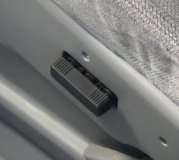The heated seat should work when the engine is running I believe, here is the only information I could find on the issue.
Rear Heated Seat Components
The rear heated seat system has one control module that controls heat operation for both the left and right rear seat. The rear heated seats system consists of the following components:
Rear seat heating control module
Body control module
Auxiliary HVAC control module
Left rear seat heating switch
Right rear seat heating switch
Left seat cushion heating element
Left seat back heating element
Right seat cushion heating element
Right seat back heating element
Rear Seat Heating Control Module Power and Ground
Battery positive voltage is supplied to the rear seat heating control module through a fuse located in the rear fuse block. This voltage is used to power up the rear seat heating control module and to supply power to the seat heater elements. Ground for the rear seat heating control module is provided at the module connection.
Rear Heated Seat Operation
Figure 1: Rear Heated Seat Block Diagram
The rear seat heated seat switches are located in the auxiliary HVAC control module. When a heated seat switch is pressed, a serial data message is sent from the auxiliary HVAC control module to the HVAC control module indicating the heated seat request. The HVAC control module serves as a gateway to transmit the message to the rear seat heating control module via the serial data line. In response to this message, the rear seat heating control module applies battery voltage through the heater element control circuits to the appropriate seat heating elements.
When the seat heating control module receives a heated seat command, it applies high side drive pulse width modulated (PWM) signals driven at the required duty cycles to generate the appropriate effective voltage to the heating elements to attain the commanded seat temperature.
The rear seat heating system utilizes a self-regulating heating element system, which is different from the non-regulated heating element systems with temperature sensors previously used on GM vehicles. In the self-regulating type of system, temperature feedback to a control module is not required for temperature regulation. The heating element material itself regulates the surface temperature based on the effective voltage applied to the heating element.
Load Shed Management
The electrical power management function is designed to monitor the vehicle electrical load and determine when the battery is potentially in a high discharge condition. The heated/cooled seat system is one of the vehicle loads that is subject to reduction during a battery discharge condition. For more information on load management refer to Electrical Power Management Description and Operation.
Tuesday, April 2nd, 2024 AT 7:54 PM


